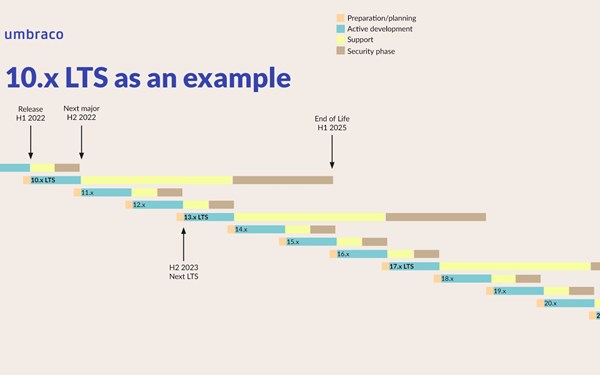
Umbraco
17 March 2022
To ensure Umbraco remains the leading Microsoft based opensource CMS the developers who work on it need to continue to enhance it as the wider digital eco-system updates and changes.
This however needs to be balanced with the ability for existing website managers to install security patches and bug fixes without having to rebuild their website every time a new version of Umbraco is released.
So to balance these two conflicting requirements Umbraco has committed to the following versioning, release cycle and long term support model.
Umbraco follows the semantic versioning of the format major.minor.patch e.g. 8.17.3. A summary of the versions and their release cycle is:
|
Major version |
Minor version |
Patch Version |
|
A version that includes breaking changes or API updates that are incompatible with previous versions |
A version with new functionality or features in a backward compatible manner. |
A version with backward compatible bug fixes or security updates |
|
Released every 6 months |
Released every 6 weeks |
Released as required |
|
Support for a major version will typically be 12 months. However every 4th major version will be supported for 36months (long term support (LTS)) |
|
Yes but back when Umbraco 7 was built it was in the good old days one of the IT staff in the council would see the arrival of a shiny new server (unboxing this was the highlight of their year). Once it was plugged in, they would then pull out a set of CD’s and install a whole bunch of different software. This server is what would run your website and would typically be upgraded every 5-10 years.
Now things have moved to the cloud and we have a web hosting architecture that looks like this with a whole lot of different technologies that are required to host one of our websites.

The underlying foundation for applications running on a Microsoft stack is .NET. This is the application framework in Azure cloud that Umbraco runs on. When Microsoft released .NET Core (the modernised version of .NET Framework) they decided to follow an agile, more rapid release cadence.
With Microsoft controlling the hardware, operating system and application framework in Azure they are able to much more rapidly release updates and features which the rest of the industry also need to keep pace with.
The upside for us is we are now seeing new versions and enhancements for a better, faster and more secure Umbraco CMS on a regular basis that we can plan for and use to provide better digital experiances for our customers and users.
Signup here if you want to keep up with our quarterly newletter